|
|
| 'Like' us on Facebook | Follow us: |
Posted on: April 07, 2017
The Story of Sai – 6
And the lessons for you and me
Part 1 || Part 2 || Part 3 || Part 4 || Part 05 || Part 07 || Part 08
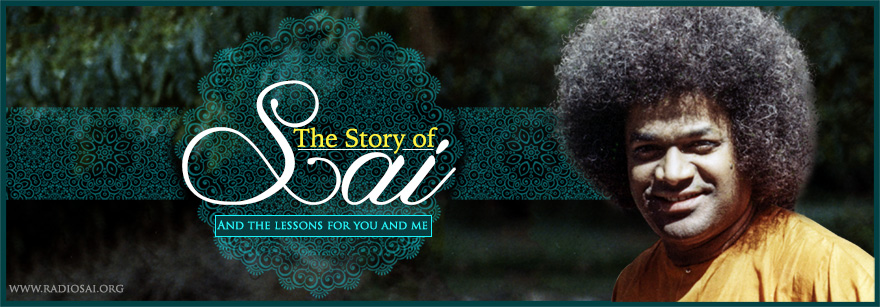 |
The antiquity of The Ramayana, The Mahabharata, and The Bhagavatha is unquestionable and indecipherable. Yet in India they are as fresh and alive in people's consciousness as the stories of their own families. Rama, Krishna, Radha, etc. are almost a part of their daily life and living. What makes these legendary tales contemporary in every age? Rama's paintings and sculptures or Krishna's images and carvings, poems on Rama's glory or discussions on Krishna's message, are as passionately done now as they happened in 3 AD or 13 AD or 1300 AD. What makes them defy time and be relevant to every society over ages? Is it the incredible heroics of Rama? Or the delightful and miraculous sport of Krishna? Or the awesome plot of these captivating poetic narrations? While all this is true, what makes these epics eternal is something more fundamental.
 |
|
| 91st Birthday Celebrations Logo - Download |
“The Ramayana and the Mahabharata are like the heart and the head of India, and are as vital to India as the heart and the head are to a human body,” Bhagawan says and goes on to state what makes these epics so vital: “Sathya and dharma are not related to merely one person, one period of time, or one country; they are related to all people, all periods of time, and all countries...” It is because these tales are nothing but beautiful elaborations of Truth and Righteousness, that they have stood the test of time and circumstance. But this essence can be grasped only if these epics are read not as scintillating stories but as reinvigorating treatises on how to lead a life anchored to Truth and Righteousness.
As much as this is true for these ancient epics, it is the same with the current Sai Bhagavatha too. Every scene and character, sequence and incident, twist and turn in the Sai Saga is for the purpose of divinising man through the practice of Truth, Righteousness, Peace and Love. But to assimilate this deeply and internalise it intensely so that it can be translated into real action, the Story of Sai needs to be not just read but meditated upon assiduously. This series, started in November 2016, commemorating Bhagawan's 91st Birthday is an attempt in this direction. We hope this will help us to reflect more profoundly on the Sai Bhagavatha and implement the lessons learnt more powerfully in our day-to-day existence.
His Story
Kondama Raju's sons, Pedda Venkama Raju and Chinna Venkama Raju, lived adjacent to their cousins, the two sons of Kondama Raju's brother. Both their homes were extremely modest. Pedda Venkama Raju's two-room house had stone walls.
One room was used to store food grains while the other served as the living room. The kitchen was located at the end of a small passageway. A few wooden poles laid horizontally with a slight slope for regulating the flow of rainwater formed the roof. A bamboo mat spread over the wooden frame and nailed to the walls substituted for tiles. A plaster of lime and a bleaching agent, chavudu, was used as waterproofing material on the roof.
 |
| The house of Pedda Venkama Raju - this picture was probably taken in the 70s |
Reflection
This was the house the Avatar chose to be born in. Let alone proper electricity and decent roads, His abode did not even have a safe roof. Would it not have been at least a little convenient for Him had He picked a house and city where He did not have to bother about basic needs such as food and shelter?
His mission He declared was to “protect the whole of mankind and confer Ananda (happiness) on all; to guide all onto the path of goodness; and to provide succour and solace to the forlorn and destitute.” Would not a reasonably well off household and comfortable environment made His task relatively easier, to begin with?
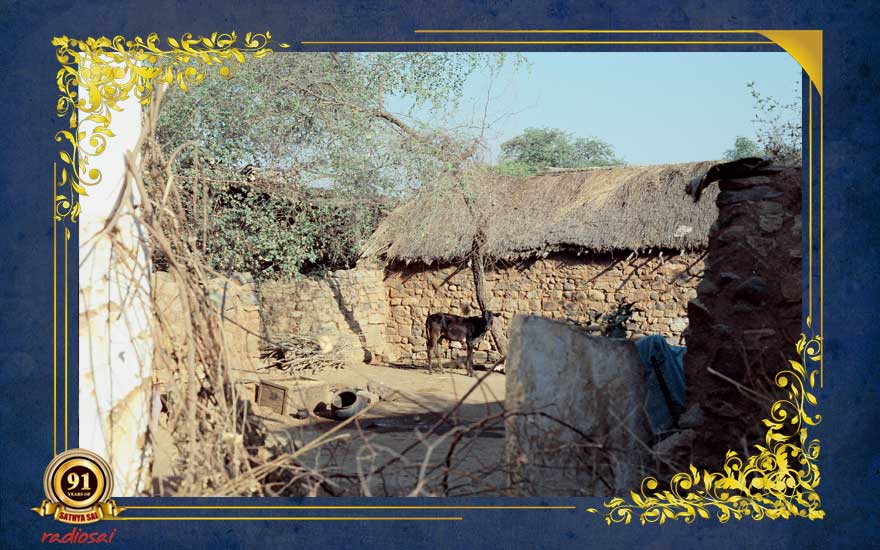 |
When we have a task at hand, our first response is to look for the right resources. If a child is told to strive for distinction in his class, he will ask for money to buy extra books or attend a special coaching class and so on.
If a marketing manager has to achieve targets, he will demand perks such as travel allowances or phone bill reimbursements. Should the government make plans to accomplish huge projects, an immediate course of action would be to levy multifarious taxes to extract massive contributions from the public.
However, when the Avatar descends with a multidimensional mammoth mission He does not look for resources, all He has is a resolve. But it is no ordinary resolve, it is Vajra Sankalpa (a will as inviolable as diamond).
Man collects resources and then resolves to achieve a target. But the Divine first resolves. Then resources automatically arrive, thanks to the sheer power and purity of His will.
How the Universe Aligns to a Pure Thought
One summer during the early nineties, Bhagawan was in 'Sai Sruthi', His abode in Kodaikanal, a little hill station in the state of Tamil Nadu. Swami had taken along with Him a small group of students and devotees.
If there was heaven on earth, that was it! That was how all those picked by Baba to be part of His entourage felt. They resided with Swami in the same house. Even before the Sun rose they saw Swami who was constantly concerned about their welfare and funfair! Baba sent them for shopping, horse-riding, sight-seeing, boating, and arranged special cooks to serve delicious dishes four times a day.
Of course, the greatest gift for them was to just mill around Swami the whole day - listen to stories directly from Him, watch amazing creations of precious gems, priceless artefacts, dazzling statues, a plethora of rings, chains, watches, and what not, and yes, take pictures with Him!
That was how blissful Kodai with Sai was!
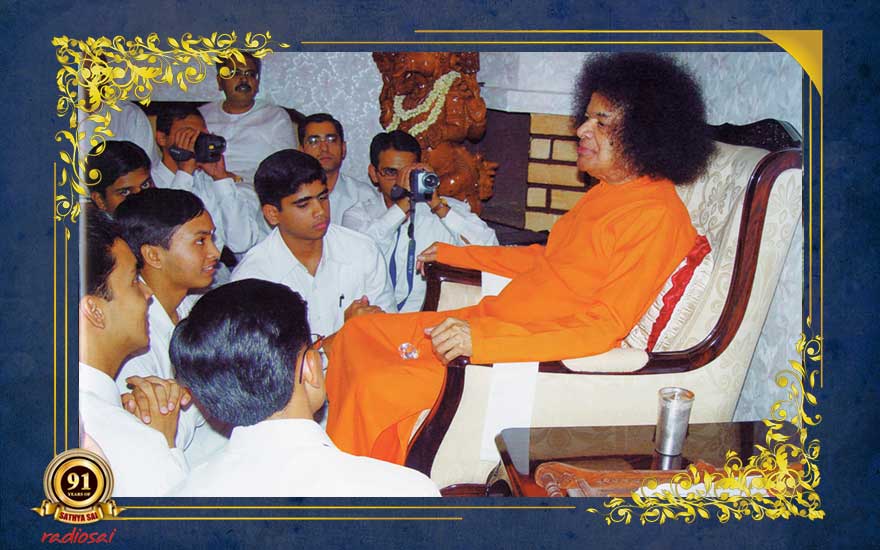 |
After about four such weeks of ecstasy, Swami and all those travelling with him would head back.
Generally, before leaving Kodai, Swami would shower all those who had served with loads of gifts. So the watchmen, washermen, cooks, gardeners, sevadals, the security, and literally anyone who had contributed even a little to make the stay of all the students and devotees in 'Sai Sruthi' comfortable would be blessed with lovely presents from Bhagawan.
One such important group was the police force. They always followed Swami's car whenever He went out and also ensured order is maintained among the crowds that converged every morning and evening for His darshan. Bhagawan gifted clothes as well as money (as stitching charges) to all the men in khaki.
During a particular visit to Kodai, the entire police force was made to sit in the Bhajan Hall one evening. Swami walked into the premises but to everyone’s surprise immediately walked out. The reason being – the boys had made preparations for 20 pairs of clothes but there were 100 members of the police sitting in the hall!
Swami enquired if there were enough clothes in stock to make new pairs. That was not a problem. The boys instantly got ready to prepare another 80 sets.
The issue, however, was money. No one had enough cash for another 80 people.
There was tension in the air. But Swami was calm. He simply said, “Wait...let me grant darshan to devotees and return.”
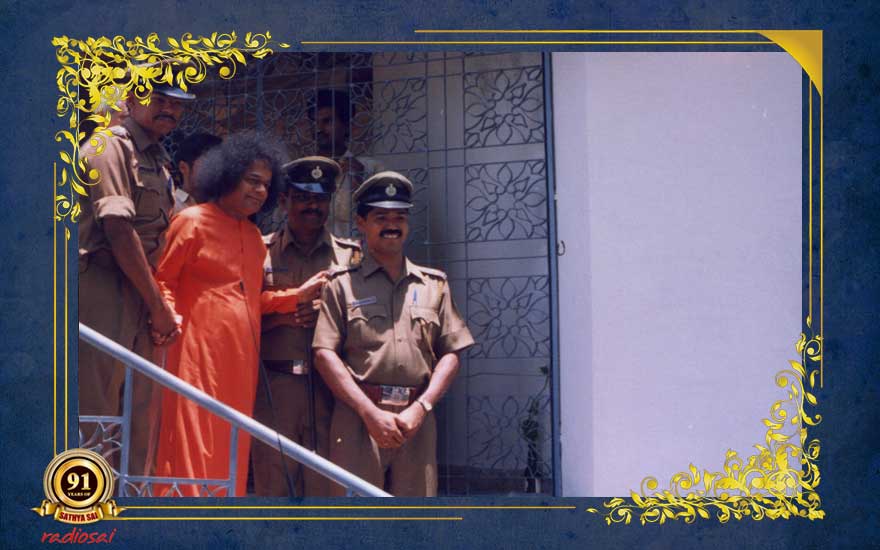 |
Once He went outside, the senior devotees inside Sai Sruthi started pooling up resources in all earnestness. Even as they desperately tried putting together the amount, Swami returned with a stash of letters in His hand.
As He entered the room one of the letters slipped from His fingers and fell onto the floor. It was picked up by a senior devotee. Incidentally he was the one who was most actively engaged in aggregating the required sum. Bhagawan now gave him a meaningful look and said, “Open the envelope”.
The gentleman slowly opened the cover. Swami then asked him to check what was inside. When he did, he was left speechless. It was money!
Bhagawan suggested he count the notes. As he finished, he just looked at Swami with wide eyes - absolutely dazed. There was subtle delight too. But he was too amazed to smile. It was the exact amount needed for the distribution.
However, that wasn’t the only extraordinary occurrence about the incident. Even more significant was what transpired next.
Swami looked at the devotee in the eye, and softly yet firmly said, “I did not use My divine power for this money. This happened just to teach you an important lesson.”
The man was still trying to fathom the immensity of His words. Graciously Bhagawan elaborated:
“Whenever you have a deep desire to make a positive difference in the lives of people, whenever you have an unquenchable thirst to give yourself away selflessly for others welfare, the forces of Nature will wrap themselves around you to make it possible. Remember this always.”
His words suggested that if there is purity of intent, all the ability and facility arrive seamlessly. That was why perhaps Swami did not have to born in a family that had electricity and connectivity; He was dependent not on such outward amenities but on His inner purity - which made everything else work out.
Secondly, only a person who can empathise with the trials and tribulations of the less privileged and desolate can do maximum good to a maximum number of the needy. Again, only the person who lives the life of the poor and the distressed can accurately empathise with those that need succour.
Only when an individual lives in the hut of a poor villager will he not only know how difficult such life is, but also realise what needs to be done to make one’s condition better.
Bhagawan too lived the life that 70% of India was living during the 30s and 40s. He too did not have clean water to drink, no shelter under heavy rains, no more than a pair of clothes, and no way to get help for the sick.
That was perhaps the reason why Swami's eyes would always get watery at the very sight of a poor man; His face would overflow with tears when He heard the plight of a desperate mother who did not have enough food for her children or a wife running from pillar to post to save her husband.
No wonder, once Swami established Prasanthi Nilayam in 1950, the first thing He did was to lay the foundation stone for a hospital to cater to the needs of the rural folk.
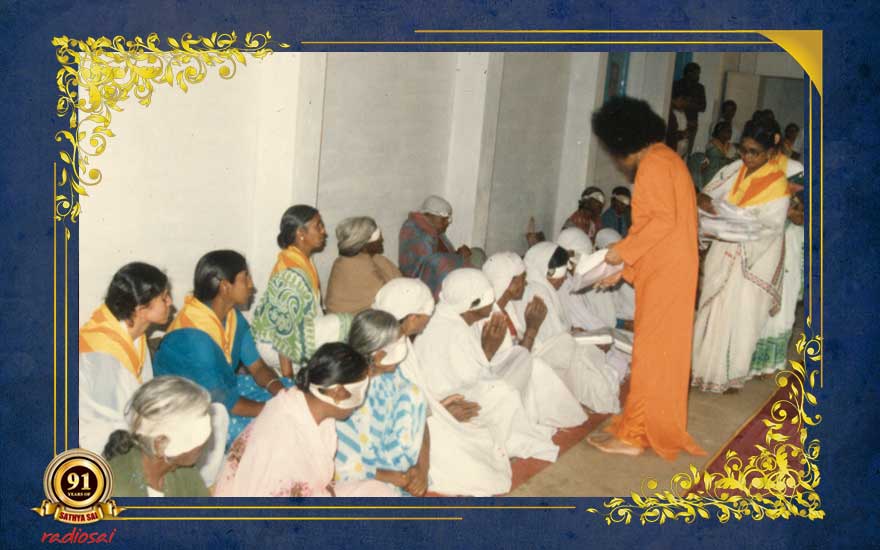 |
The Avatar was indeed demonstrating through His own life the fundamental principle of enlightened leadership – to feel for the other heart. That truly is not only the mark of a great leader but also as Swami says, the sign of every cultured man too as culture is synonymous with 'concern for others'.
Part 1 || Part 2 || Part 3 || Part 4 || Part 05 || Part 07 || Part 08
- Bishu Prusty
Radio Sai Team
| comments powered by Disqus |






